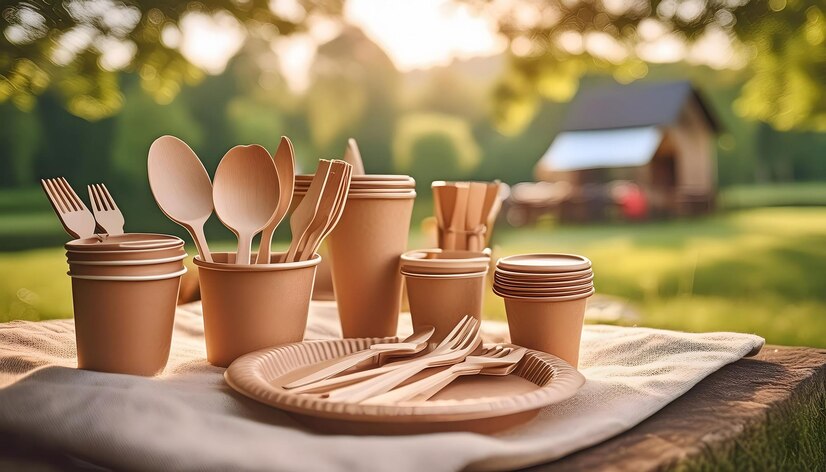Tableware is Changing the Future of Disposable Products

Our Story
Arecanut Tableware is Changing the Future of Disposable Products
In recent years, the growing concern over environmental pollution, particularly plastic waste, has sparked a global movement toward sustainability. As a result, disposable products, traditionally made from plastic and other non-biodegradable materials, are being reevaluated. One such innovation in the eco-friendly sector is arecanut tableware. This sustainable alternative is gaining popularity for its minimal environmental impact, versatility, and unique aesthetic appeal.
In this blog, we’ll explore how arecanut tableware is revolutionizing the disposable product industry and why it may hold the key to a greener future.
1. Eco-Friendly Production Process
Arecanut tableware stands out due to its environmentally responsible production. The plates and bowls are made from the fallen sheaths of the areca palm, meaning no trees are cut down in the process. Unlike plastic, which relies on fossil fuels and harmful chemicals, arecanut production is completely natural. The leaves are simply cleaned, pressed into shape, and dried, resulting in a product with a minimal carbon footprint.
The simplicity of the production process reduces the amount of energy and water consumed, making it a sustainable alternative to traditional disposable options like paper or plastic. Additionally, because it uses raw materials that would otherwise go to waste, arecanut tableware helps minimize agricultural by-products and contributes to a circular economy.
2. Biodegradability and Compostability
One of the most pressing issues with disposable plastic products is that they can take hundreds of years to decompose, often ending up in landfills or polluting oceans. In contrast, arecanut tableware is 100% biodegradable and compostable, breaking down naturally within 60 to 90 days when disposed of correctly. This rapid decomposition makes it an ideal choice for consumers who are looking to minimize their environmental impact without sacrificing convenience.The compostable nature of arecanut products also means that, instead of creating waste, they can return nutrients to the soil, enriching it and supporting new plant growth. This contrasts sharply with plastic, which contributes to the growing microplastics crisis, infiltrating ecosystems and food chains.
3. Aesthetic and Functional Appeal
Apart from its environmental benefits, arecanut tableware offers a unique aesthetic appeal. The natural texture and grain of the areca palm leaf create beautiful, rustic-looking plates and bowls that add a touch of elegance to any occasion. Whether it’s a picnic, wedding, or corporate event, arecanut tableware elevates the dining experience, making it a popular choice for eco-conscious consumers and event planners alike.
In terms of functionality, arecanut plates and bowls are highly durable. They are leakproof, heat-resistant, and sturdy enough to hold both hot and cold foods, making them a practical choice for everyday use. Unlike flimsy paper or plastic plates, arecanut products do not warp or soften when used with liquid-based dishes, providing a reliable alternative to traditional disposables.
4. A Shift in Consumer Mindset
The rise of arecanut tableware reflects a broader shift in consumer preferences. More and more people are prioritizing sustainability in their purchasing decisions, particularly when it comes to single-use products. With increasing awareness of the environmental and health consequences of plastic, consumers are actively seeking out alternatives that are both planet-friendly and safe to use.
This growing demand for sustainable products is also driving innovation in the disposable tableware industry. Brands and manufacturers are now investing in greener materials and production methods to meet consumer expectations. As a result, arecanut tableware is not only disrupting the traditional disposable market but also encouraging a larger shift toward sustainability in the industry.
5. Future Outlook: Scaling the Impact
While arecanut tableware is currently making waves in niche markets, its potential to scale globally is immense. Governments and organizations worldwide are increasingly implementing bans on single-use plastics, creating a growing demand for viable alternatives. As production processes become more streamlined and efficient, arecanut tableware has the potential to become a mainstream solution for eco-friendly disposable products.
In addition to this, the versatility of arecanut leaves could inspire further innovation in the sustainable products space. As more companies and consumers recognize the value of biodegradable and compostable materials, we may see arecanut being used for packaging, cutlery, and other everyday disposable items.
Conclusion
Arecanut tableware represents a significant step forward in the quest for sustainable disposable products. Its eco-friendly production, biodegradability, aesthetic appeal, and functionality make it a promising alternative to plastic and paper disposables. As the world continues to prioritize sustainability, arecanut tableware is well-positioned to play a key role in shaping the future of disposable products, offering a solution that is not only environmentally responsible but also practical and beautiful.
The rise of arecanut tableware reflects a shift in the way we think about disposables—moving away from waste and toward a more circular, sustainable future.
Let’s Bring Nature Into Your Lovely House
Use these paragraphs to focus on the topic in the headline. Make sure you keep it short and attractive.
